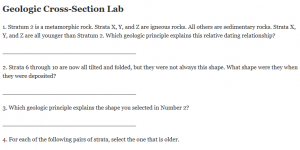Geologic Cross-Section Lab

1. Stratum 2 is a metamorphic rock. Strata X, Y, and Z are igneous rocks. All others are sedimentary rocks. Strata X, Y, and Z are all younger than Stratum 2. Which geologic principle explains this relative dating relationship?
____________________________________
2. Strata 6 through 10 are now all tilted and folded, but they were not always this shape. What shape were they when they were deposited?
____________________________________
3. Which geologic principle explains the shape you selected in Number 2?
____________________________________
4. For each of the following pairs of strata, select the one that is older.
a) 2 or 6 _______ b) 8 or 9 _______ c) 10 or 14 _______ d) Z or 2 _______
e) Z or 6 _______ f) Z or 12 _______ g) Z or 19 _______ h) X or 2 _______
i) X or 8 _______ j) X or 6 _______ k) Y or 2 _______ l) Y or 6 ______
The image below is a cross-section of an area in northern New Mexico where two dikes cut across numerous sedimentary rock formations. The dikes are composed of igneous rocks that contain a very small but significant amount of radioactive isotope X.
5. Use your knowledge of relative dating and the principles of geologic to place each of the following geologic units and events in order from oldest (Event 1) to youngest (Event
Deposition of Beds 1 through 4
Deposition of Beds 10 through 13
Deposition of Beds 5 through 9
Erosion Event 1
Erosion Event 2
Erosion Event 3
Formation of Schist
Intrusion of Dike A
Intrusion of Dike B
Uplift and Tilting of Beds 5 through 9
Uplift and Tilting/Folding of Schist and Beds 1-4
Order the 12 events here:
a. __________________________________
b. __________________________________
c. __________________________________
d. __________________________________
e. __________________________________
f. __________________________________
g. __________________________________
h. __________________________________
i. __________________________________
j. __________________________________
k. __________________________________
l. _________________________________
The image below is a radioactive decay curve for the radioactive isotope X present in the schist and in dikes A and B. The x-axis is the age of the isotope in millions of years and the y-axis is the percentage of parent isotope X remaining. Use this decay curve to answer the following questions about the geologic cross-section you just analyzed.
6. The date of metamorphism of the schist is ___________ million years ago.
7. The date of the intrusion of Dike A is ___________ million years ago.
8. The date of the intrusion of Dike B is ___________ million years ago.
9. Based on the radioactive decay curve, the half-life of radioactive isotope X is __________ million years.
Because of the Principle of Included Fragments we cannot use numerical dating to determine the ages of the sedimentary rocks in the geologic cross-section. However, we can bracket the ages of these rocks using relative dating and the known ages of those rocks we can radiometrically date. Use the following geologic time scale to answer the last three questions regarding the ages of the sedimentary rocks in the geologic cross-section:
10. Over which geologic time periods did Beds 1 through 4 form?
_________________________________________
11. Over which geologic time periods did Beds 5 through 9 form?
_________________________________________
12. Bed 10 could not be any older than the _____________________ period.